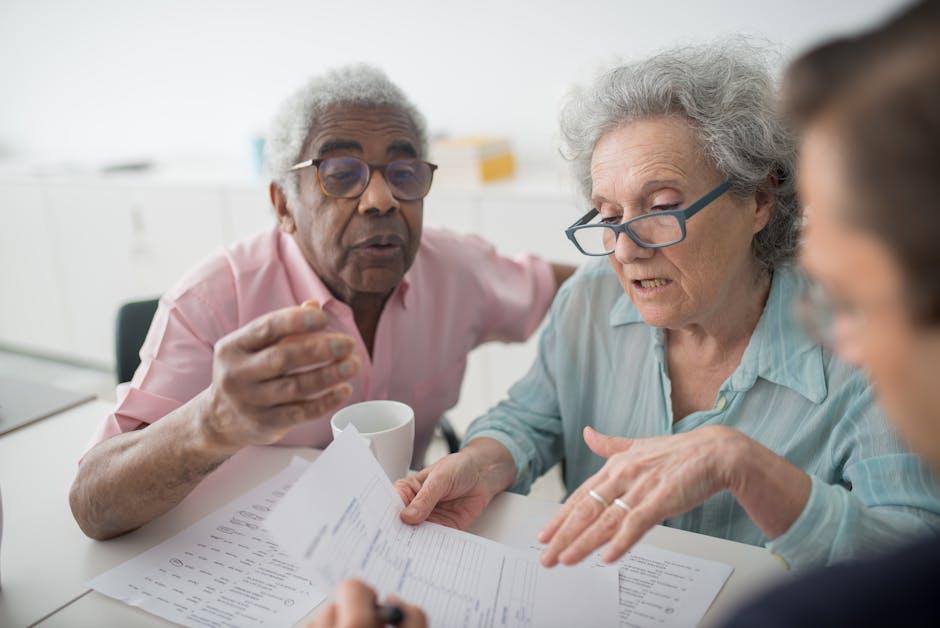In an era marked by rapid technological advancements and an increasingly complex financial landscape, investors are constantly seeking innovative solutions to secure their financial futures. One such breakthrough in the realm of personal finance is the advent of robo-advisors. These automated platforms leverage sophisticated algorithms and machine learning to provide personalized investment strategies, aiming to optimize returns while mitigating risks. This article delves into the mechanics of robo-advisors, evaluating their efficacy in portfolio management, cost-efficiency, and accessibility, and explains how these digital advisors are reshaping the investment landscape for both novice and seasoned investors alike.
Understanding the Role of Robo-Advisors in Modern Investment Strategies
In today’s fast-paced world, robo-advisors have become a pivotal element in modern investment strategies. These AI-driven platforms offer automated financial planning services with minimal human intervention, often tailored to your personal risk tolerance and investment goals. They use algorithms to provide recommendations on a diverse range of asset allocations, ensuring your portfolio is well-balanced and optimized for growth. There are several key advantages to using these sophisticated tools:
- Cost-Effective: Lower fees compared to traditional financial advisors.
- Accessibility: Available 24/7 and easy to use via web and mobile apps.
- Automation: Regular portfolio rebalancing and tax-loss harvesting.
- Personalization: Personalized plans based on your financial profile.
- Transparency: Clear insights into fees and performance metrics.
To illustrate the impact of robo-advisors, let’s look at a quick comparison between traditional methods and automated options:
| Feature | Traditional Advisors | Robo-Advisors |
|---|---|---|
| Access Time | Limited to office hours | 24/7 availability |
| Cost | High fees | Low fees |
| Personalization | Manual inputs by advisors | Algorithm-driven |

Evaluating Key Features and Capabilities of Leading Robo-Advisory Platforms
When it comes to choosing the right robo-advisory platform, evaluating key features and capabilities is crucial. Among the significant elements to consider are investment portfolios, which vary in customization and risk tolerance options. Some platforms offer a more hands-off investment approach with predefined portfolios, while others provide extensive customization where users can adjust their asset allocations. Additionally, fees and costs are major factors—robo-advisors generally charge lower fees compared to traditional financial advisors, but these fees can still vary. Always check for hidden charges or additional fees for premium services.
Another essential factor is the user interface and experience. A user-friendly design can significantly enhance your experience, making it easier to monitor and manage investments. Features like goal tracking and financial planning tools can help you stay on track with your financial objectives. Moreover, customer support can vary widely across platforms, with some offering 24/7 support and others providing limited access. the security measures in place to protect your financial data are paramount. Look for platforms that offer encryption, multi-factor authentication, and other advanced security features.
| Feature | Importance |
|---|---|
| Investment Portfolios | High |
| Fees and Costs | High |
| User Interface | Medium |
| Customer Support | Medium |
| Security Measures | High |

Implementing a Robo-Advisor for Personalized Financial Planning
Integrating a robo-advisor into financial planning can revolutionize how you manage your money. These advanced tools use algorithms and data analytics to offer investment advice tailored specifically for you. By analyzing your financial status, risk tolerance, and future goals, a robo-advisor provides a personalized plan that adjusts in real-time. No more guesswork or relying solely on human advisors; now, you can get precise, data-driven recommendations anytime. Additionally, these platforms often come with user-friendly dashboards that make tracking your financial progress straightforward and intuitive.
Here are some key features you’ll find in a high-quality robo-advisor platform:
- Automated Portfolio Management: Continually rebalance your investments to optimize returns.
- Tax-Loss Harvesting: Minimize tax liabilities by strategically selling off investments that incur losses.
- Goal-Based Planning: Tailor your savings plan for specific objectives like retirement, buying a house, or education funds.
| Feature | Benefit |
|---|---|
| Automated Portfolio Management | Optimizes returns |
| Tax-Loss Harvesting | Minimizes tax liabilities |
| Goal-Based Planning | Customizes savings strategy |

Recommendations for Optimizing Returns with Automated Investment Tools
When it comes to optimizing returns with automated investment tools, diversification is key. Robo-advisors utilize algorithms to create balanced portfolios that spread investments across various asset classes. Diversifying your investments helps reduce risk and can lead to more stable returns over time. Additionally, most robo-advisors offer personalized financial planning based on your risk tolerance and investment goals. Regularly reviewing your portfolio and making adjustments as needed can further enhance your financial outcomes. Key factors to consider include:
- Risk Tolerance: Choose a risk level that aligns with your financial goals.
- Fees: Opt for platforms with lower fees to maximize your returns.
- Automatic Rebalancing: Ensure your platform rebalances your portfolio periodically.
Furthermore, effective tax management can substantially impact your overall returns. Many robo-advisors offer tax-loss harvesting, a strategy to offset gains with losses, ultimately reducing tax liability. It’s also beneficial to understand the different types of accounts available, such as taxable accounts and tax-advantaged retirement accounts (IRAs). These considerations can enhance the efficiency of your investments, allowing you to fully harness the potential of automated tools.
| Feature | Benefit |
|---|---|
| Diversification | Mitigates risk |
| Tax-Loss Harvesting | Reduces tax impact |
| Low Fees | Maximizes net gains |
| Automatic Rebalancing | Keeps portfolio aligned |
Q&A
Q&A:
Q1: What are robo-advisors and how do they operate?
A1: Robo-advisors are automated, algorithm-driven financial planning services with minimal to no human supervision. They utilize advanced algorithms and mathematical models to provide investment advice and manage client portfolios. Users input their financial goals, risk tolerance, and investment timeline, and the robo-advisor leverages this data to create and manage a diversified portfolio. Typically, the process involves continuous monitoring and rebalancing to optimize returns and manage risk according to the client’s profile.
Q2: What technology underpins robo-advisors?
A2: Robo-advisors leverage several key technologies:
- Algorithms and Machine Learning: Algorithms analyze large datasets to provide optimal investment strategies, while machine learning can improve these recommendations over time.
- Big Data Analytics: Extensive data collection and analysis techniques enhance decision-making processes, enabling personalized investment strategies.
- APIs (Application Programming Interfaces): These streamline data exchange between financial institutions and robo-advisory platforms, integrating market data and client information seamlessly.
- Cloud Computing: This ensures scalability, enabling robo-advisors to handle large volumes of data processing and client interactions efficiently.
Q3: What are the primary benefits of using a robo-advisor for financial planning?
A3: The primary benefits of robo-advisors include:
- Cost Efficiency: Lower management fees compared to traditional financial advisors due to minimal human intervention.
- Accessibility: 24/7 availability and user-friendly interfaces make financial planning more accessible to a broader audience.
- Customization: Personalized investment recommendations based on user-specific inputs such as financial goals and risk tolerance.
- Efficiency: Automated processes ensure continuous monitoring and quick adaptation to market changes, providing optimized portfolio management.
Q4: Are there limitations or risks associated with robo-advisors?
A4: While robo-advisors offer numerous advantages, several limitations or risks should be noted:
- Limited Personalization: Despite advanced algorithms, robo-advisors may lack the nuanced understanding of individual circumstances that a human advisor can provide.
- Market Dependence: They can only perform within the constraints of the market data and algorithms they rely on; unforeseen market conditions may challenge their effectiveness.
- Data Security: As digital platforms, robo-advisors are susceptible to cybersecurity threats, necessitating robust data protection measures.
- Regulatory Compliance: Ensuring compliance with financial regulations is crucial, as legal issues could impact service reliability and client trust.
Q5: How do robo-advisors compare to traditional human financial advisors in terms of performance?
A5: In general, robo-advisors often provide competitive performance, especially for beginners or those seeking cost-effective solutions. They excel in delivering systematic, data-driven investment strategies that can rival traditional advisors in standard portfolio management tasks. However, for more complex financial planning needs, such as estate planning or tax strategies, human advisors may offer superior value through personalized insights and experience.
Q6: How is regulatory compliance managed in the robo-advisor industry?
A6: Robo-advisors must adhere to financial regulations set by entities like the Securities and Exchange Commission (SEC) in the United States and other relevant regulatory bodies worldwide. Compliance involves routine audits, transparent reporting, robust data protection policies, and adaptive measures to align with changing regulations. Automated systems can aid compliance by ensuring consistent application of rules, but maintaining up-to-date, human oversight remains critical to navigating complex regulatory landscapes.
By harnessing the power of technology, robo-advisors present a compelling option for investors seeking accessible, cost-efficient, and data-driven financial planning solutions. However, users must weigh the benefits against the potential limitations and ensure rigorous evaluation of platforms to secure their financial futures effectively.
The Way Forward
as the financial landscape continues to evolve, integrating technology into investment strategies is not just a trend but a prudent approach to securing a robust financial future. Robo-advisors, with their advanced algorithms and data-driven insights, offer an efficient, cost-effective, and accessible solution for investors looking to diversify their portfolios and achieve their long-term financial goals. By leveraging automated platforms, investors can benefit from personalized financial advice, reduced fees, and timely market adjustments—all crucial components in navigating the complexities of today’s dynamic economic environment.
As with any financial decision, it is essential to thoroughly evaluate the options available and consider factors such as risk tolerance, investment goals, and the specific features offered by various robo-advisors. The symbiotic relationship between human expertise and machine precision holds significant promise for the future of wealth management. Staying informed and proactive in adopting innovative financial tools will be key to maximizing returns and ensuring financial stability in the years to come.
By embracing the capabilities of robo-advisors, investors can better position themselves to capitalize on market opportunities, adapt to economic shifts, and ultimately, secure their financial future with greater confidence and ease.


